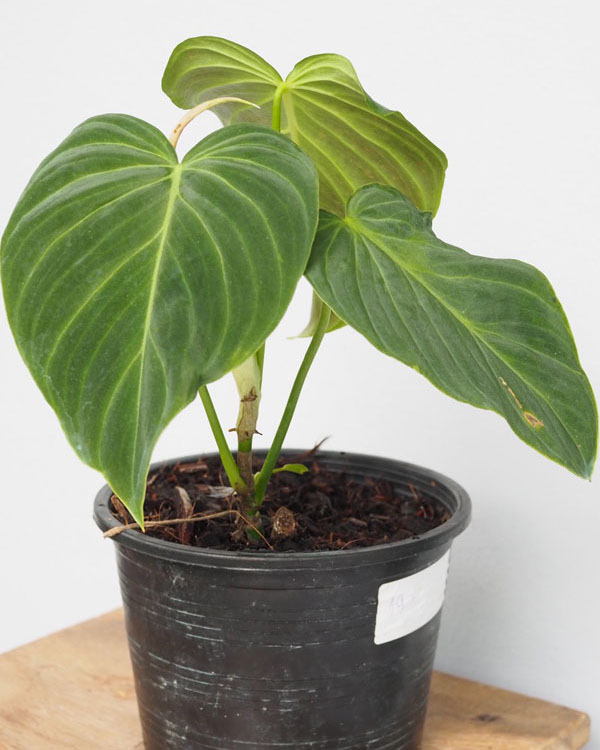7 Essential Tips for Philodendron Splendid Care: Thrive Easily!
The Philodendron Splendid is a stunning variety from the Araceae family, loved for its elegantly crafted foliage and climbing vines. Though this vining Philodendron is reasonably fuss-free, ensuring it gets proper care is essential for its growth and longevity. This blog post details 7 vital care tips for your Philodendron Splendid to thrive effortlessly!
Philodendron Splendid thrives best in bright, indirect light.
What is Bright, Indirect Light?
- Bright light that is filtered and not directly hitting the plant.
- Near an east, west or slightly shaded south window.
Effects of Inadequate Light
Insufficient light can result in:
- Leggy, weak growth.
- Sparse foliage.
- Loss of leaf variegation.
- Infrequent flowering (if it is mature).
To maximize light exposure, rotate the plant periodically and prune back any leggy growth. Keep it near the brightest window where the sun's rays do not directly hit the foliage.
Optimizing Light Conditions
- Acclimate the plant gradually if moving it from a low light area.
- Use sheer curtains to diffuse harsh light from western or southern windows.
- Supplement with grow lights if sunlight is inadequate. Place fluorescent bulbs 6 to 12 inches above the plant for 12 to 16 hours daily.
Getting the right amount of bright, indirect light is key for the Splendid to thrive gracefully!

Philodendron Splendid prefers average room temperatures between 65-80°F/ 18-27°C during the day and around 60°F/15°C at night.
Effects of Temperature Extremes
Temperatures outside this range can negatively impact your Philodendron:
- Hot or cold drafts can scorch and dry out the foliage.
- Chilling temperatures below 55°F (13°C) can halt growth.
- Overheating above 80°F (27°C) can cause leaf scorch.
Regulating Temperature
- Keep the plant away from drafty areas, air vents, and direct heat sources like fireplaces.
- Move it to a cooler spot or use circulating fans during hot summers.
- Install a space heater or use plant heating pads when temperatures drop too low.
- Group plants together to elevate ambient humidity.
Maintaining even, comfortable temperatures will keep your Philodendron looking its best throughout the seasons. Monitor conditions and adjust as needed.
Philodendrons hail from tropical environments and appreciate humid conditions between 50-70% humidity.
Impacts of Dry Air
Low humidity can lead to:
- Dry, shriveled leaves.
- Browning leaf tips and margins.
- Increased susceptibility to pests.
Boosting Humidity Levels
- Use a humidifier near the plant.
- Set the plant atop a pebble tray filled with water.
- Regularly mist the leaves using soft or distilled water.
- Group plants together to elevate local humidity.
- Keep the plant in a bathroom or kitchen where humidity tends to be higher.
Closely observe your Philodendron and increase humidity if you notice dry air effects. Proper moisture in the air prevents distress and keeps the foliage looking lush.

"Experience the beauty of lush foliage with your own Philodendron Splendid. Don't wait – add this stunning plant to your collection today!"
Philodendron Splendid enjoys slightly moist but not soggy or bone-dry soil.
Signs it Needs Watering
- Soil is dry an inch below the surface.
- Leaves appear limp or curled inward.
- Foliage looks dull.
Watering Best Practices
- Water deeply until it runs from the drainage holes.
- Allow the top few inches to dry out between waterings.
- Water less often in winter when growth slows.
- Use lukewarm, soft, or distilled water if possible.
Dangers of Overwatering
Excess moisture can lead to:
- Root rot due to soggy soil.
- Leaf spot diseases.
- Decline in foliage health.
Let the top section dry before watering again. Pour water until it flows freely from the pot's bottom drainage holes. This encourages stronger roots to form deeper in the soil.
Increasing air flow around your Philodendron inhibits disease and mimics its natural environment.
Benefits of Air Circulation
Good airflow:
- Prevents fungal and bacterial leaf diseases.
- Strengthens stem growth.
- Distributes moisture evenly through soil.
- Discourages pests.
Improving Air Movement
- Use circulating fans to gently blow air around the plant.
- Open windows regularly for fresh air exchange.
- Space plants appropriately to allow air to flow between them.
- Trim back overcrowded growth to enhance air penetration.
Boosting air circulation gives your Philodendron Splendid the touch of wind it would experience growing outdoors in nature!

Apply a balanced diluted liquid or slow release fertilizer to nourish your Philodendron Splendid.
Signs it Needs Fertilizer
- Paler leaves with minimal new growth.
- Leaf size shrinking over time.
- Lackluster, stunted appearance.
Fertilizing Best Practices
- Fertilize monthly spring through summer when actively growing.
- Use a balanced houseplant fertilizer diluted to half strength.
- Apply soluble fertilizer with each watering.
- Resume fertilizing after winter dormancy ends.
- Flush soil every few months to prevent buildup.
Avoid overfertilizing, which can burn the roots and leaves. Regular, moderate feeding keeps your Philodendron thriving vigorously.
Pruning is beneficial for shaping your Philodendron Splendid and improving its health.
Reasons to Prune
- Remove leggy, damaged, or diseased growths.
- Control size and form.
- Boost bushiness and fullness.
- Eliminate crossing or congested vines.
Pruning Best Practices
- Use clean, sharp shears or scissors.
- Cut just above a node or leaf when shaping.
- Time pruning for early spring before the growing period.
- Propogate cuttings or discard disease-laden clippings.
Regular pruning maintains an attractive, tidy appearance and encourages lush, vibrant new growth.
Caring for the glorious Philodendron Splendid is easy when you focus on providing bright, indirect light, average room temperatures, decent humidity, moist soil, proper fertilization, and occasional pruning. Pay attention to its needs and intervene when required to maintain optimal conditions. With a little attentive effort, your Philodendron Splendid will reward you with vigorous, show-stopping beauty for years to come!
https://bit.ly/3H7Lt0a
1. Provide Bright, Indirect Light
Philodendron Splendid thrives best in bright, indirect light.
What is Bright, Indirect Light?
- Bright light that is filtered and not directly hitting the plant.
- Near an east, west or slightly shaded south window.
Effects of Inadequate Light
Insufficient light can result in:
- Leggy, weak growth.
- Sparse foliage.
- Loss of leaf variegation.
- Infrequent flowering (if it is mature).
To maximize light exposure, rotate the plant periodically and prune back any leggy growth. Keep it near the brightest window where the sun's rays do not directly hit the foliage.
Optimizing Light Conditions
- Acclimate the plant gradually if moving it from a low light area.
- Use sheer curtains to diffuse harsh light from western or southern windows.
- Supplement with grow lights if sunlight is inadequate. Place fluorescent bulbs 6 to 12 inches above the plant for 12 to 16 hours daily.
Getting the right amount of bright, indirect light is key for the Splendid to thrive gracefully!

2. Maintain Average Room Temperature
Philodendron Splendid prefers average room temperatures between 65-80°F/ 18-27°C during the day and around 60°F/15°C at night.
Effects of Temperature Extremes
Temperatures outside this range can negatively impact your Philodendron:
- Hot or cold drafts can scorch and dry out the foliage.
- Chilling temperatures below 55°F (13°C) can halt growth.
- Overheating above 80°F (27°C) can cause leaf scorch.
Regulating Temperature
- Keep the plant away from drafty areas, air vents, and direct heat sources like fireplaces.
- Move it to a cooler spot or use circulating fans during hot summers.
- Install a space heater or use plant heating pads when temperatures drop too low.
- Group plants together to elevate ambient humidity.
Maintaining even, comfortable temperatures will keep your Philodendron looking its best throughout the seasons. Monitor conditions and adjust as needed.
3. Provide Average to High Humidity
Philodendrons hail from tropical environments and appreciate humid conditions between 50-70% humidity.
Impacts of Dry Air
Low humidity can lead to:
- Dry, shriveled leaves.
- Browning leaf tips and margins.
- Increased susceptibility to pests.
Boosting Humidity Levels
- Use a humidifier near the plant.
- Set the plant atop a pebble tray filled with water.
- Regularly mist the leaves using soft or distilled water.
- Group plants together to elevate local humidity.
- Keep the plant in a bathroom or kitchen where humidity tends to be higher.
Closely observe your Philodendron and increase humidity if you notice dry air effects. Proper moisture in the air prevents distress and keeps the foliage looking lush.

"Experience the beauty of lush foliage with your own Philodendron Splendid. Don't wait – add this stunning plant to your collection today!"
4. Water Thoroughly When Top Inch is Dry
Philodendron Splendid enjoys slightly moist but not soggy or bone-dry soil.
Signs it Needs Watering
- Soil is dry an inch below the surface.
- Leaves appear limp or curled inward.
- Foliage looks dull.
Watering Best Practices
- Water deeply until it runs from the drainage holes.
- Allow the top few inches to dry out between waterings.
- Water less often in winter when growth slows.
- Use lukewarm, soft, or distilled water if possible.
Dangers of Overwatering
Excess moisture can lead to:
- Root rot due to soggy soil.
- Leaf spot diseases.
- Decline in foliage health.
Let the top section dry before watering again. Pour water until it flows freely from the pot's bottom drainage holes. This encourages stronger roots to form deeper in the soil.
5. Increase Air Circulation
Increasing air flow around your Philodendron inhibits disease and mimics its natural environment.
Benefits of Air Circulation
Good airflow:
- Prevents fungal and bacterial leaf diseases.
- Strengthens stem growth.
- Distributes moisture evenly through soil.
- Discourages pests.
Improving Air Movement
- Use circulating fans to gently blow air around the plant.
- Open windows regularly for fresh air exchange.
- Space plants appropriately to allow air to flow between them.
- Trim back overcrowded growth to enhance air penetration.
Boosting air circulation gives your Philodendron Splendid the touch of wind it would experience growing outdoors in nature!

6. Fertilize Regularly During Growth Periods
Apply a balanced diluted liquid or slow release fertilizer to nourish your Philodendron Splendid.
Signs it Needs Fertilizer
- Paler leaves with minimal new growth.
- Leaf size shrinking over time.
- Lackluster, stunted appearance.
Fertilizing Best Practices
- Fertilize monthly spring through summer when actively growing.
- Use a balanced houseplant fertilizer diluted to half strength.
- Apply soluble fertilizer with each watering.
- Resume fertilizing after winter dormancy ends.
- Flush soil every few months to prevent buildup.
Avoid overfertilizing, which can burn the roots and leaves. Regular, moderate feeding keeps your Philodendron thriving vigorously.
7. Prune Back Overgrown Sections
Pruning is beneficial for shaping your Philodendron Splendid and improving its health.
Reasons to Prune
- Remove leggy, damaged, or diseased growths.
- Control size and form.
- Boost bushiness and fullness.
- Eliminate crossing or congested vines.
Pruning Best Practices
- Use clean, sharp shears or scissors.
- Cut just above a node or leaf when shaping.
- Time pruning for early spring before the growing period.
- Propogate cuttings or discard disease-laden clippings.
Regular pruning maintains an attractive, tidy appearance and encourages lush, vibrant new growth.
Conclusion
Caring for the glorious Philodendron Splendid is easy when you focus on providing bright, indirect light, average room temperatures, decent humidity, moist soil, proper fertilization, and occasional pruning. Pay attention to its needs and intervene when required to maintain optimal conditions. With a little attentive effort, your Philodendron Splendid will reward you with vigorous, show-stopping beauty for years to come!
https://bit.ly/3H7Lt0a
Nhận xét
Đăng nhận xét